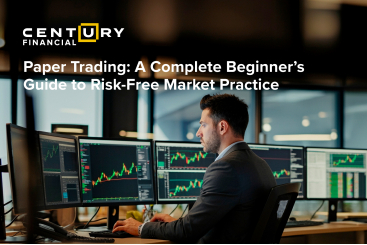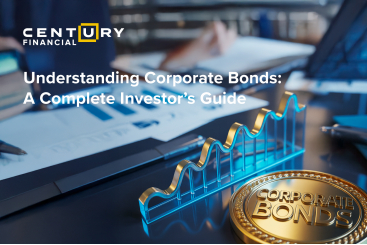Tuesday, May 07, 2024
How to Find Undervalued Stocks: A Step-by-Step Guide
By Century Financial in 'Blog'

.jpg)
Synopsis:
This short article will show you how to find discounted stocks. It will also help you acquire fundamental analytical skills to uncover an exciting investing concept. Practical tactics to identify undervalued stocks will give you the confidence to select better stocks for your portfolio.
Consider this scenario:You're shopping for a garment, and you come across one that's 60% off than its regular price. Naturally, you'd be thrilled with the value you're getting.
Now, replace the garment with shares; The only difference is you won’t see any advertised sales of it and that the share price might rise or fall in the future compared to its current price.
Stocks that investors perceive to be trading below their actual worth are known as undervalued stocks They have the potential to rise in the future when the market eventually recognises a company's actual value.
The art lies in identifying the undervalued share from the list of shares available in the stock market. Using a mix of Quantitative and Qualitative Measures can help you find the potential undervalued stock.
Quantitative Analysis
Quantitative Analysis involves using mathematical and statistical techniques to analyse financial data. Some metrics you can check are:
| Particulars | Defination | Formula |
| Price-to-Earnings Ratio (P/E) |
The price-to-earnings (P/E) ratio measures a company's share price relative to its earnings per share (EPS) and helps assess the relative value of its stock. P/E ratios are most valuable when comparing similar companies in the same industry or for a single company over time. |
P/E Ratio = Market value per share / Earnings per share A high P/E ratio could mean a company's stock is overvalued or investors expect high growth rates. |
| Price-to-Book Ratio (P/B) |
This ratio is calculated by dividing the company's current stock price per share by its book value per share (BVPS). It reflects the value market participants attach to a company's equity relative to its book value. |
P/B Ratio = Market Price per Share / Book Value per Share Value investors typically consider P/B ratios under 1.0 solid investments. A good P/B ratio is relative to a business and its industry. |
| Dividend Yield |
The dividend yield—displayed as a percentage—is the amount of money a company pays shareholders for owning a share of its stock divided by its current stock price. |
Dividend Yield = Annual Dividends Per Share / Price Per Share |
| PEG ratio | A PEG ratio takes the P/E ratio and factors in the stock’s expected earnings growth. A low PEG ratio and strong earnings may indicate an undervalued stock. |
P/E ratio / EPS growth rate A PEG lower than 1.0 is best, suggesting a company is relatively undervalued. |
| Free Cash Flow | Free cash flow (FCF) represents a company's cash generated after accounting for cash outflows to support operations and maintain its capital assets. Looking at FCF is also helpful for potential shareholders or lenders who want to evaluate how likely the company will be able to pay its expected dividends or interest. |
|
Qualitative Analysis
Qualitative analysis in business subjectively assesses a company's value using non-quantifiable factors like management, industry trends, R&D, and labour relations. Some metrics you can check are:
Competitive Advantage (Economic Moat)
An economic moat is a company's distinct advantage over its competitors, allowing it to protect its market share and profitability. A comprehensive economic moat is challenging to mimic or duplicate (e.g., brand identity, patents) and thus creates an effective barrier against competition from other firms.
.jpg)
Management Quality
A company's management quality indicates how well its leaders make decisions, manage resources, and achieve goals.
"Stick to proven management with a lot of integrity, talent and passion. After some other mistakes, I learned to go into business only with people I like, trust, and admire"
One of the ways to do that is to start learning about a company’s management by gathering historical and current articles written about the top managers.
Look for evidence in four primary areas – honesty, passion, transparency, and competence.
Debt Levels
A company's debt ratio tells the leverage it uses by comparing total debt to total assets.
It is calculated by dividing total liabilities by assets, with higher debt ratios indicating higher degrees of debt financing.
Whether or not a debt ratio is "good" depends on the context, such as the company's industrial sector and the prevailing interest rate.


Industry Trends
Some industries experience favourable trends (rising demand, government support, new technologies) that boost companies' prospects, while others face challenges. Growing industries often provide fertile ground for finding undervalued stocks.
Finding Undervalued Stocks
Stock Screeners
There are various screeners available on the net. The power of stock screeners lies in setting specific criteria that align with your value investing philosophy. Some examples of filters could be as follows:



Contrarian Investing
As the name suggests, thinking differently is against the herd or overlooked by the market. Contrarian opportunities might be found:



Bottom line
Finding undervalued stocks requires a combination of number crunching and understanding the bigger picture. Don't be afraid to look beyond the obvious; that's often where the hidden value lies. Remember, patience and a thorough analysis are your key allies in uncovering potential gems.
The content in this blog, including any research, analysis, opinions, forecasts, or other information (collectively, "Information"), is provided by Century Financial Consultancy LLC (CFC) for marketing, educational, and general informational purposes only. It should not be construed as investment advice, a recommendation, or a solicitation to buy or sell any financial instruments.
This Information may also be published across various channels, including CFC’s website, third-party platforms, newsletters, marketing materials, emails, social media, messaging apps, webinars, and other communications. While CFC strives for accuracy, we do not guarantee the completeness, reliability, or timeliness of any content. Any decisions made based on this Information are at your own risk. CFC accepts no liability for any loss or damage arising from its use.
Trading financial products involves significant risk and may not be suitable for all investors. Please ensure you fully understand the risks and seek independent professional advice if necessary.
Please refer to the full risk disclosure mentioned on our website.









.png)
.png)
.png)
.png)


